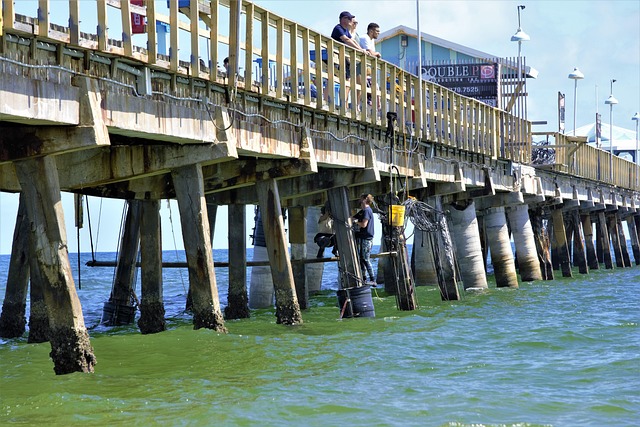Pier and beam foundations, common in commercial buildings, require regular maintenance for longevity. Structural issues like settlement, moisture intrusion, and weather events demand prompt repair, preventing costly failures. Comprehensive inspections identify damage, guiding tailored repairs using advanced materials and techniques. Modern restoration involves data-driven solutions, precise measurements, and innovative materials to enhance stability. Correct tools, safety precautions, demolition, and quality control ensure effective repairs. Case studies offer insights into successful mitigation strategies. Regular inspections, preventative maintenance, and smart materials are future trends enhancing foundation repair's efficiency and sustainability.
“In the realm of commercial construction, understanding the intricacies of pier and beam foundations is paramount for structural integrity. This article serves as a comprehensive guide to addressing a critical aspect of building maintenance: Commercial Pier and Beam Repair. From deciphering the basics of these foundation systems to exploring advanced restoration techniques, we delve into essential practices. We examine common damage causes, provide an in-depth look at inspection methods, and offer a step-by-step approach for successful repairs. Additionally, case studies highlight effective strategies, while preventive tips ensure long-term stability.”
Understanding Pier and Beam Foundations: A Basic Overview

Pier and beam foundations are a common structural support system in many commercial buildings, providing stability and distributing weight efficiently. This type of foundation consists of vertical piers, typically made of concrete or steel, connected to horizontal beams that rest on the ground. The beams then transfer the load from the structure above to the piers, which bear the weight and distribute it across a larger area, often into the soil beneath.
Regular maintenance and repairs are crucial for ensuring the longevity and integrity of pier and beam foundations. Over time, various factors like environmental conditions, heavy loads, or poor construction can lead to damage, such as cracks in beams or piers, misalignments, or settling. Prompt identification and repair of these issues are essential to prevent further deterioration and costly structural failures, making Pier and Beam Foundation Repair a vital service for commercial property managers and owners.
Common Causes of Commercial Pier and Beam Damage

Commercial pier and beam foundations are susceptible to damage over time, with several common causes that require professional Pier and Beam Foundation Repair. One primary factor is structural settlement, often resulting from changes in soil conditions or improper construction. This can lead to cracks in beams, columns, or walls, compromising the integrity of the entire structure.
Another significant cause is moisture intrusion, especially in regions with high humidity levels or frequent rainfall. Water can seep into the wood components, causing rot and subsequent weakness, which may necessitate partial or complete beam replacement. Additionally, extreme weather events like storms or earthquakes can exert immense force on these foundations, leading to misalignment, fractures, or even total collapse, underlining the need for prompt repair and reinforcement.
Inspection and Assessment for Effective Repair Strategies

A thorough inspection and assessment are the foundation for any successful pier and beam foundation repair strategy. Before initiating any work, it’s crucial to comprehensively evaluate the structural integrity of the pier and beam system. This involves meticulous examination of every component—from the wooden beams and posts to the supporting piers and the soil beneath them—to identify any signs of damage, rot, or instability. Professionals skilled in pier and beam foundation repair utilize advanced tools and techniques, such as moisture meters and load-bearing tests, to gain a detailed understanding of the structure’s current state.
This initial step is vital because it allows for tailored repair solutions. For instance, if rot is detected in specific beams, targeted replacement can be undertaken, minimizing unnecessary alteration or expense. Assessment also helps in determining whether the issue lies with individual components or the overall foundation design, guiding engineers to implement effective and lasting repairs that address the root cause.
Advanced Techniques in Pier and Beam Restoration

In the realm of commercial property maintenance, pier and beam foundation repair stands out as a specialized art. Advanced techniques have emerged to address this complex structure’s unique challenges. Modern restoration methods involve meticulous evaluation, utilizing advanced technology for precise measurements and structural analysis. This data-driven approach allows experts to tailor solutions, ensuring the integrity and longevity of these foundational elements.
One innovative technique involves the use of advanced materials, such as high-strength composites and specialized epoxy injections, which can strengthen and stabilize beams, piers, and supporting structures. These modern fixes not only repair but also enhance the overall stability and load-bearing capacity of the pier and beam foundation, making them a game-changer in commercial property upkeep.
Materials and Equipment Essential for Successful Repairs

When undertaking pier and beam foundation repair, having the right materials and equipment is crucial for successful outcomes. Traditional methods often involve using steel beams, concrete, rebar, and specialized epoxy or polymeric injectors for structural support and stabilization. These materials are essential to replace deteriorated wood members, secure shifting piles, and reinforce the entire foundation structure.
Proper tools include jackhammers, hand tools for disassembly, welding equipment, and load-testing devices. Advanced technologies like hydraulic jacks, laser levels, and digital measuring tools also enhance precision and efficiency during the repair process. Ensuring you have a well-stocked arsenal of both conventional and modern equipment will significantly contribute to the quality and longevity of your pier and beam foundation repair project.
Step-by-Step Guide to Restoring a Commercial Structure's Foundation

Restoring a commercial structure’s pier and beam foundation involves careful, systematic steps to ensure long-lasting stability and safety. Here’s a step-by-step guide for tackling this critical repair process.
1. Inspection and Assessment: Begin by thoroughly inspecting the entire pier and beam system, identifying any signs of damage, corrosion, or settlement. This includes visual checks and, if necessary, non-invasive testing to pinpoint problem areas accurately. In terms of pier and beam foundation repair, understanding the extent of the damage is key to developing an effective restoration plan.
2. Safety Measures: Before proceeding, ensure the safety of your team and the building’s occupants by securing the area and implementing temporary structural support if required. Safety should always be the top priority during any commercial structure repairs, especially when dealing with foundational elements like piers and beams.
3. Demolition and Preparation: Remove any damaged or deteriorated components, ensuring proper disposal according to local regulations. Clean the affected areas, removing debris and old construction materials. This step prepares the foundation for reconstruction, creating a clean canvas for rebuilding.
4. Repair and Reinforcement: Repair or replace damaged beams, piers, and connectors using suitable materials and techniques. For instance, steel plates or brackets might be used to reinforce weak points. The goal is to restore structural integrity while ensuring longevity against future damage.
5. Realignment and Stabilization: If the foundation has settled unevenly, use jacking techniques to realign the structure. Stabilize it with temporary supports until permanent repairs are in place. This step ensures the building stands securely on its foundation.
6. Quality Control and Testing: After completing the repairs, conduct thorough testing to verify the structural soundness of the foundation. Load tests or other quality control measures can confirm that the pier and beam system is safe and stable under expected loads.
Case Studies: Successful Pier and Beam Repair Projects

Successful Pier and Beam Repair projects offer valuable insights into the effective restoration of commercial structures. These case studies highlight the significance of early detection and prompt action in mitigating potential structural damage. By examining real-world examples, businesses can gain a clearer understanding of common issues afflicting pier and beam foundations, such as settlement cracks, tilting walls, and uneven floors.
Through these case studies, it becomes evident that specialized techniques like underpinning, pier replacement, and beam stabilization have proven successful in numerous scenarios. Each project demonstrates the expertise required to assess unique challenges, implement tailored solutions, and ensure structural integrity. Adhering to industry best practices and employing advanced repair methods has led to remarkable outcomes, revitalizing commercial spaces and securing their long-term stability.
Preventive Measures and Long-Term Maintenance Tips

Regular inspection is key to identifying potential issues early on, allowing for more effective pier and beam foundation repair. Property owners should periodically check for signs of damage, such as cracks in the beams or pier supports, loose connections, or any visible shifting. Implementing a preventative maintenance routine can significantly extend the life of these structural elements.
To promote long-term stability, consider maintaining proper drainage around the structure. Moisture accumulation near piers and beams can accelerate corrosion and weaken the foundation. Additionally, regular cleaning and sealing of wooden components can protect against pests and weather damage. Using high-quality, water-resistant materials during repairs or replacements ensures better longevity.
Future Trends in Commercial Pier and Beam Engineering

As technology advances, future trends in commercial pier and beam engineering promise innovative solutions for repairs and enhanced structural integrity. One emerging trend is the integration of smart materials that can self-heal minor cracks and adapt to changing environmental conditions, extending the lifespan of these foundations. Additionally, digital modeling and 3D printing are set to revolutionize repair processes, allowing for precise, customized replacements and reduced construction times.
Another significant development is the increased focus on sustainability in pier and beam foundation repairs. Engineers are exploring eco-friendly materials and techniques, such as recycled steel and advanced composites, to minimize environmental impact while maintaining structural efficiency. These trends signal a promising future for commercial Pier and Beam Foundation Repair, combining cutting-edge technology with sustainable practices to deliver robust, long-lasting solutions.
